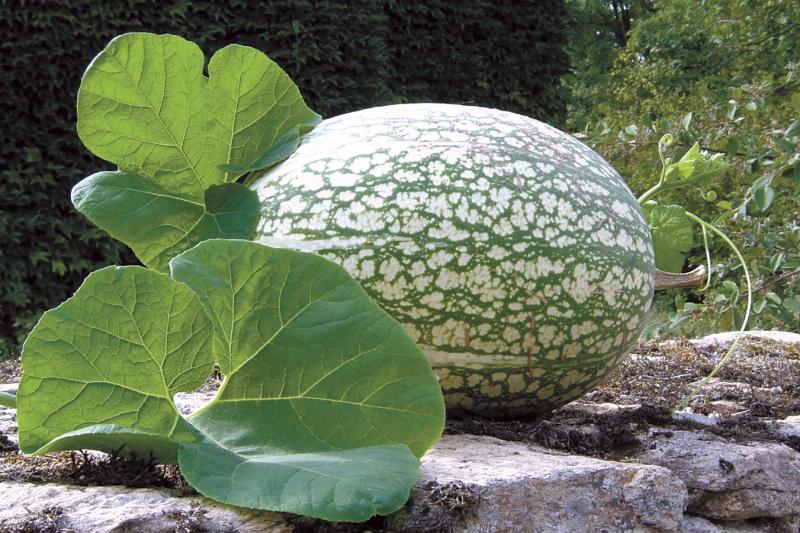The queen in “Alice In Wonderland” introduces Alice to the mock turtle, which is, as she says, “What mock turtle soup is made from.” In fact, mock turtle soup replaces real turtle meat with calf’s head meat that will give the soup a thick, gelatin-like texture. Today, instead of turtle soup, the rage is for shark fin soup, dating back to the Ming dynasty, and served to impress guests at Chinese weddings and banquets. Like turtle meat in turtle soup, the shark fins don’t give much flavor, but rather give the soup its famous thick texture.
Luckily for sharks, as well as squeamish gardeners, there is a melon that can mimic the texture of shark fins in soup, the aptly named Shark Fin squash (Cucurbita ficifolia). Also known as Seven Year melon, Fig Leaf gourd and Malabar gourd, these watermelon-like squash are easy to grow. And much easier than spearing a shark.
The eight-inch-long, creamy white squash with green stripes has edible black seeds and leaves. The squash yield up to 50 fruits on climbing vines. At one time this was the most widespread squash variety in the Americas, grown from Argentina to Mexico.
Even though the flowers, leaves and tender shoots are popular in Mexico, it is the protein-rich seeds that have real nutritional value. Roasted, they can be added to salads or pressed for oil.
Scientific studies show that this squash has a hypoglycemic effect along with a very high D-Chiro-Inositol content.
Seeds are available from specialty seed companies such as Kitazawa Seed Company (www.kitazawaseed.com, 201 4th St., No. 206, Oakland, CA 94607; phone 510-595-1188) and Sand Hill Preservation Center (www.sandhillpreservation.com, 1878 230th St., Calamus, IA 52729).
Plant shark fin squash after all danger of frost has past and the soil has warmed up. They do best on a trellis but can be allowed to trail along the ground. Ideally a soil of pH of 6.0 to 6.7 though they will do fine in soil pH of 5.5-7.5. Feed with a good organic fertilizer or compost tea. Water deeply at least once a week. If you give the plants too little water, the fruit quality will suffer. Raised beds warm up faster and are ideal for this squash. A loose mulch of grass clippings, straw or even chopped leaves will keep the roots cool.
Even though insects will do a good job of pollinating the squash, you may want to take matters into your own hands. To ensure pollination, especially in the beginning of the season, you can try hand pollinating with an artist brush. Simply dip the brush into the male flower and dust the female flower with the pollen. You can tell the female flower because it has a small squash at the base of the blossom.
For a unique garden experience plant some Shark Fin melons and make your own faux shark fin soup.
And while only a handful of people are killed by sharks every year, we slaughter over 100 million sharks annually, often throwing away the body and only saving the fins for shark fin soup.
And that is a faux pas.






















































